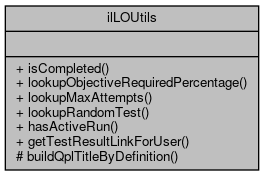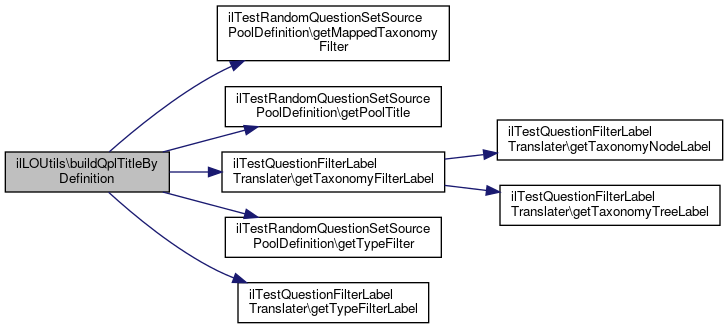This file is part of ILIAS, a powerful learning management system published by ILIAS open source e-Learning e.V. More...
 Collaboration diagram for ilLOUtils:
Collaboration diagram for ilLOUtils:Static Public Member Functions | |
| static | isCompleted (int $a_cont_oid, int $a_test_rid, int $a_objective_id, int $max_points, int $reached, int $limit_perc) |
| Check if objective is completed. More... | |
| static | lookupObjectiveRequiredPercentage (int $a_container_id, int $a_objective_id, int $a_test_ref_id, int $a_max_points) |
| static | lookupMaxAttempts (int $a_container_id, int $a_objective_id, int $a_test_ref_id) |
| static | lookupRandomTest (int $a_test_obj_id) |
| static | hasActiveRun (int $a_container_id, int $a_test_ref_id, int $a_objective_id) |
| static | getTestResultLinkForUser (int $a_test_ref_id, int $a_user_id) |
Static Protected Member Functions | |
| static | buildQplTitleByDefinition (ilTestRandomQuestionSetSourcePoolDefinition $def, ilTestQuestionFilterLabelTranslater $trans) |
Detailed Description
This file is part of ILIAS, a powerful learning management system published by ILIAS open source e-Learning e.V.
ILIAS is licensed with the GPL-3.0, see https://www.gnu.org/licenses/gpl-3.0.en.html You should have received a copy of said license along with the source code, too.
If this is not the case or you just want to try ILIAS, you'll find us at: https://www.ilias.de https://github.com/ILIAS-eLearning Settings for LO courses
Definition at line 24 of file class.ilLOUtils.php.
Member Function Documentation
◆ buildQplTitleByDefinition()
|
staticprotected |
Definition at line 156 of file class.ilLOUtils.php.
References ilTestRandomQuestionSetSourcePoolDefinition\getMappedTaxonomyFilter(), ilTestRandomQuestionSetSourcePoolDefinition\getPoolTitle(), ilTestQuestionFilterLabelTranslater\getTaxonomyFilterLabel(), ilTestRandomQuestionSetSourcePoolDefinition\getTypeFilter(), and ilTestQuestionFilterLabelTranslater\getTypeFilterLabel().
 Here is the call graph for this function:
Here is the call graph for this function:◆ getTestResultLinkForUser()
|
static |
Definition at line 175 of file class.ilLOUtils.php.
References $DIC, $valid, ilObjTest\_getActiveIdOfUser(), ilObjTest\_getTestIDFromObjectID(), ilObject\_lookupObjId(), ANONYMOUS_USER_ID, and ilObjTestAccess\visibleUserResultExists().
Referenced by ILIAS\Containter\Content\ObjectiveRenderer\buildAccordionTitle(), ILIAS\Containter\Content\ObjectiveRenderer\buildObjectiveProgressBar(), and ilLOMemberTestResultTableGUI\createTestResultLink().
 Here is the call graph for this function:
Here is the call graph for this function: Here is the caller graph for this function:
Here is the caller graph for this function:◆ hasActiveRun()
|
static |
Definition at line 170 of file class.ilLOUtils.php.
Referenced by ILIAS\Containter\Content\ObjectiveRenderer\showObjectives().
 Here is the caller graph for this function:
Here is the caller graph for this function:◆ isCompleted()
|
static |
Check if objective is completed.
Definition at line 29 of file class.ilLOUtils.php.
References ILIAS\LTI\ToolProvider\$settings, ilObject\_lookupObjId(), and ilLOSettings\getInstanceByObjId().
Referenced by ilLOTestQuestionAdapter\updateQuestionResult().
 Here is the call graph for this function:
Here is the call graph for this function: Here is the caller graph for this function:
Here is the caller graph for this function:◆ lookupMaxAttempts()
|
static |
Definition at line 91 of file class.ilLOUtils.php.
References $DIC, $ilDB, $res, ilObject\_lookupObjId(), ilDBConstants\FETCHMODE_OBJECT, and ilLOTestAssignments\getInstance().
Referenced by ilLOTestQuestionAdapter\initUserResult().
 Here is the call graph for this function:
Here is the call graph for this function: Here is the caller graph for this function:
Here is the caller graph for this function:◆ lookupObjectiveRequiredPercentage()
|
static |
Definition at line 61 of file class.ilLOUtils.php.
References ILIAS\LTI\ToolProvider\$settings, ilObject\_lookupObjId(), ilLOTestAssignments\getInstance(), ilLOSettings\getInstanceByObjId(), ilLORandomTestQuestionPools\lookupLimit(), and ilCourseObjectiveQuestion\loookupTestLimit().
Referenced by ilLOTestQuestionAdapter\initUserResult().
 Here is the call graph for this function:
Here is the call graph for this function: Here is the caller graph for this function:
Here is the caller graph for this function:◆ lookupRandomTest()
|
static |
Definition at line 112 of file class.ilLOUtils.php.
References $DIC, ilObjTest\_lookupRandomTest(), and ilObjectFactory\getInstanceByRefId().
Referenced by ilLOEditorStatus\lookupQuestionsAssigned(), and ilCourseObjectivesTableGUI\parse().
 Here is the call graph for this function:
Here is the call graph for this function: Here is the caller graph for this function:
Here is the caller graph for this function:The documentation for this class was generated from the following file:
- Modules/Course/classes/Objectives/class.ilLOUtils.php













